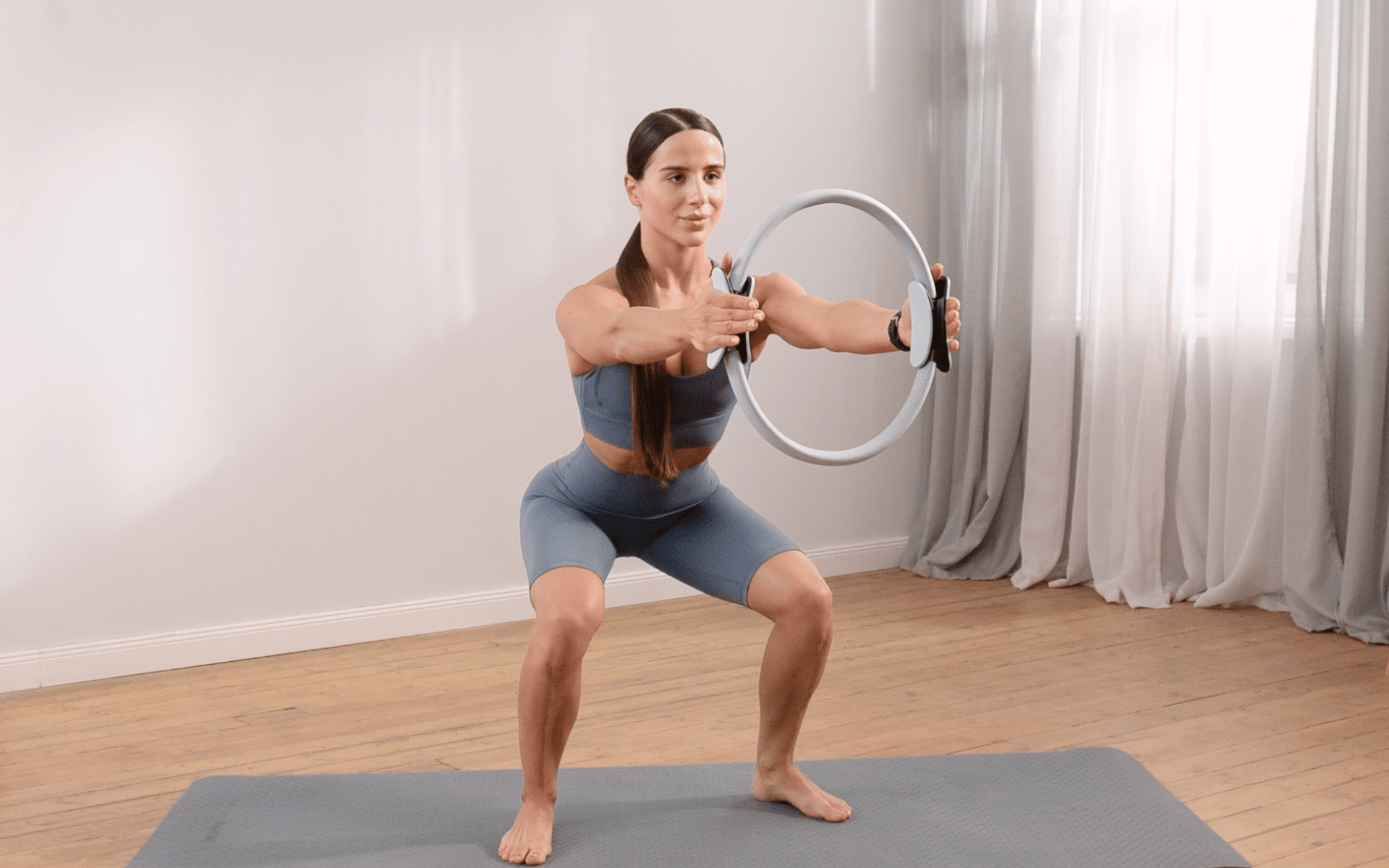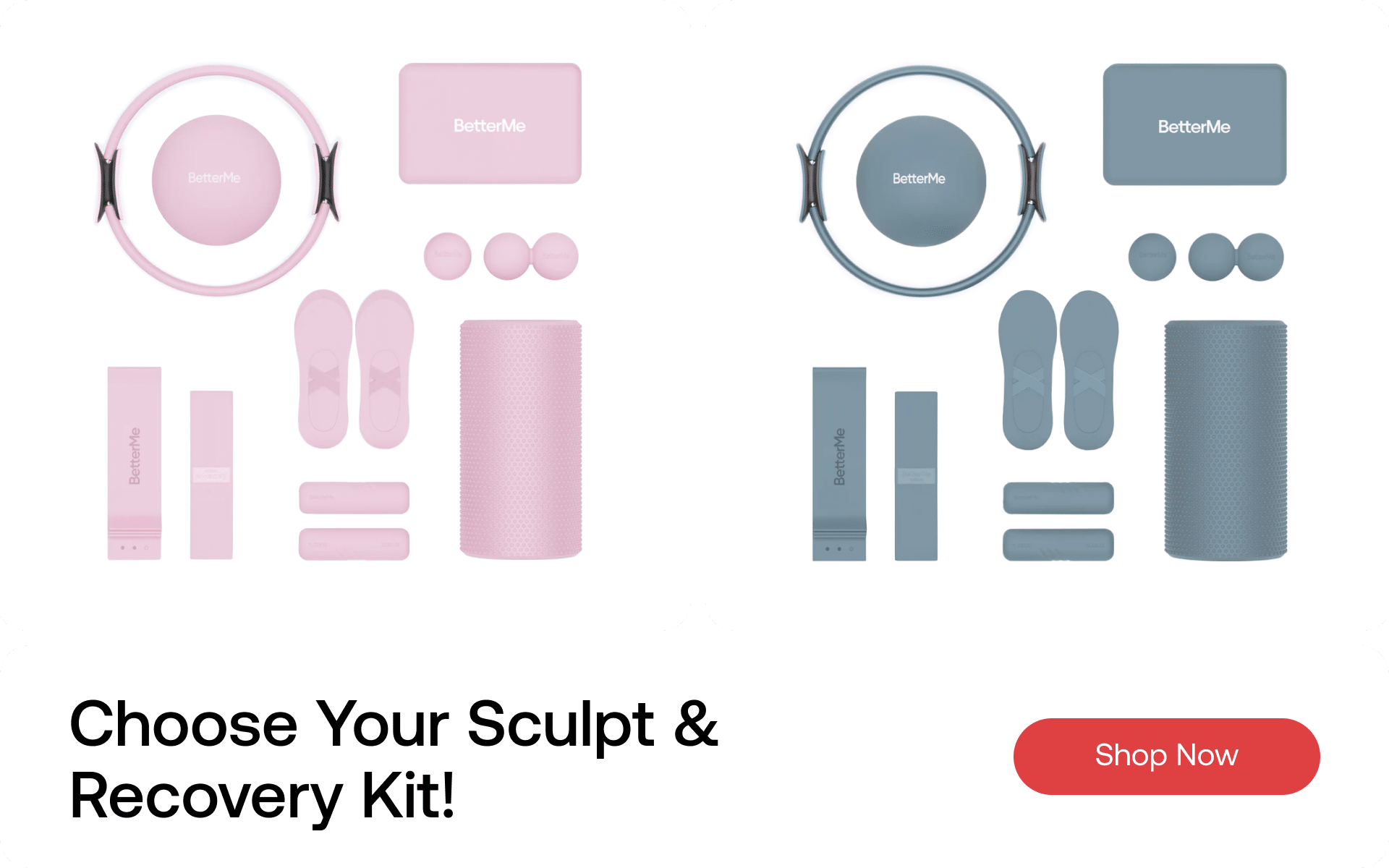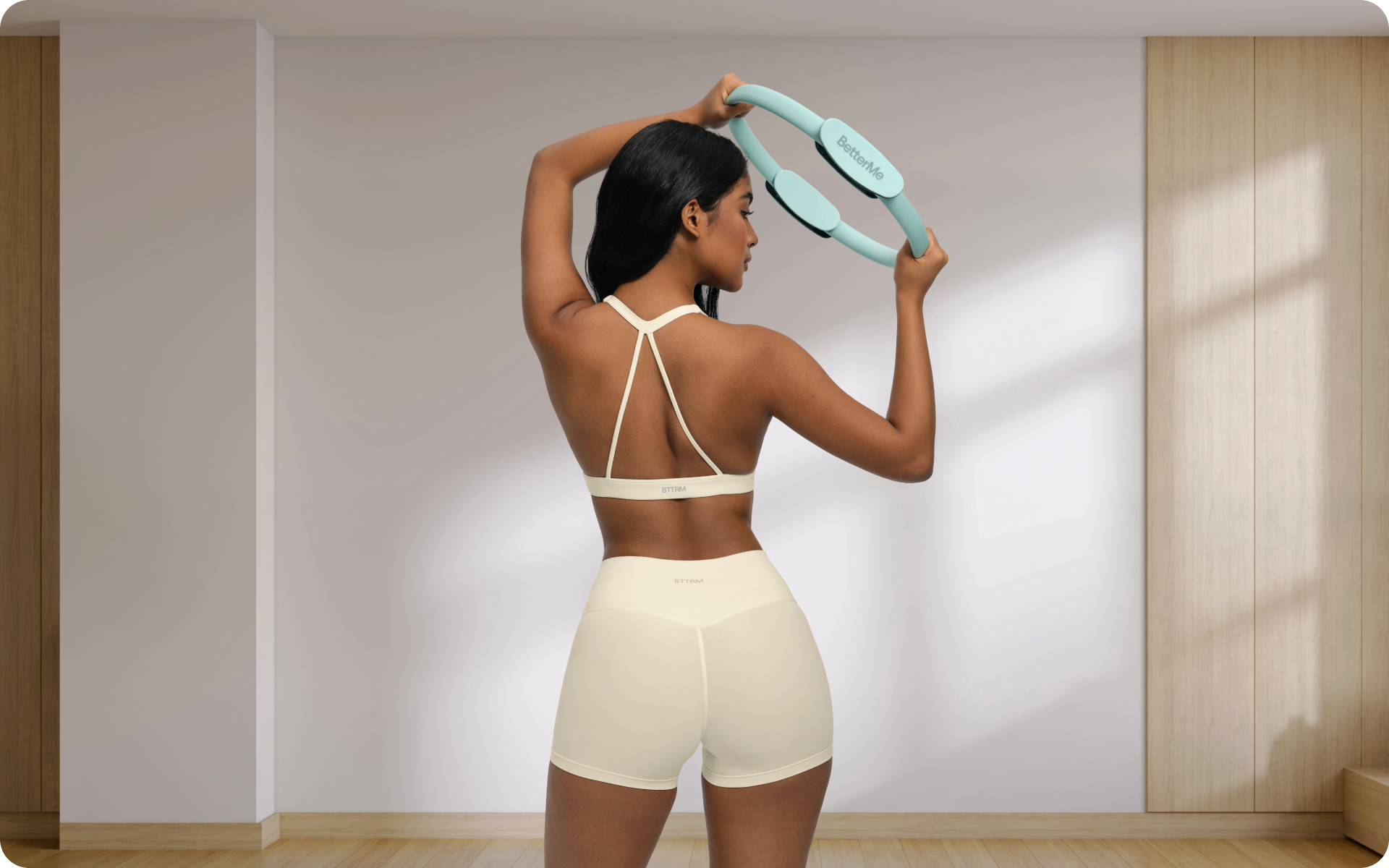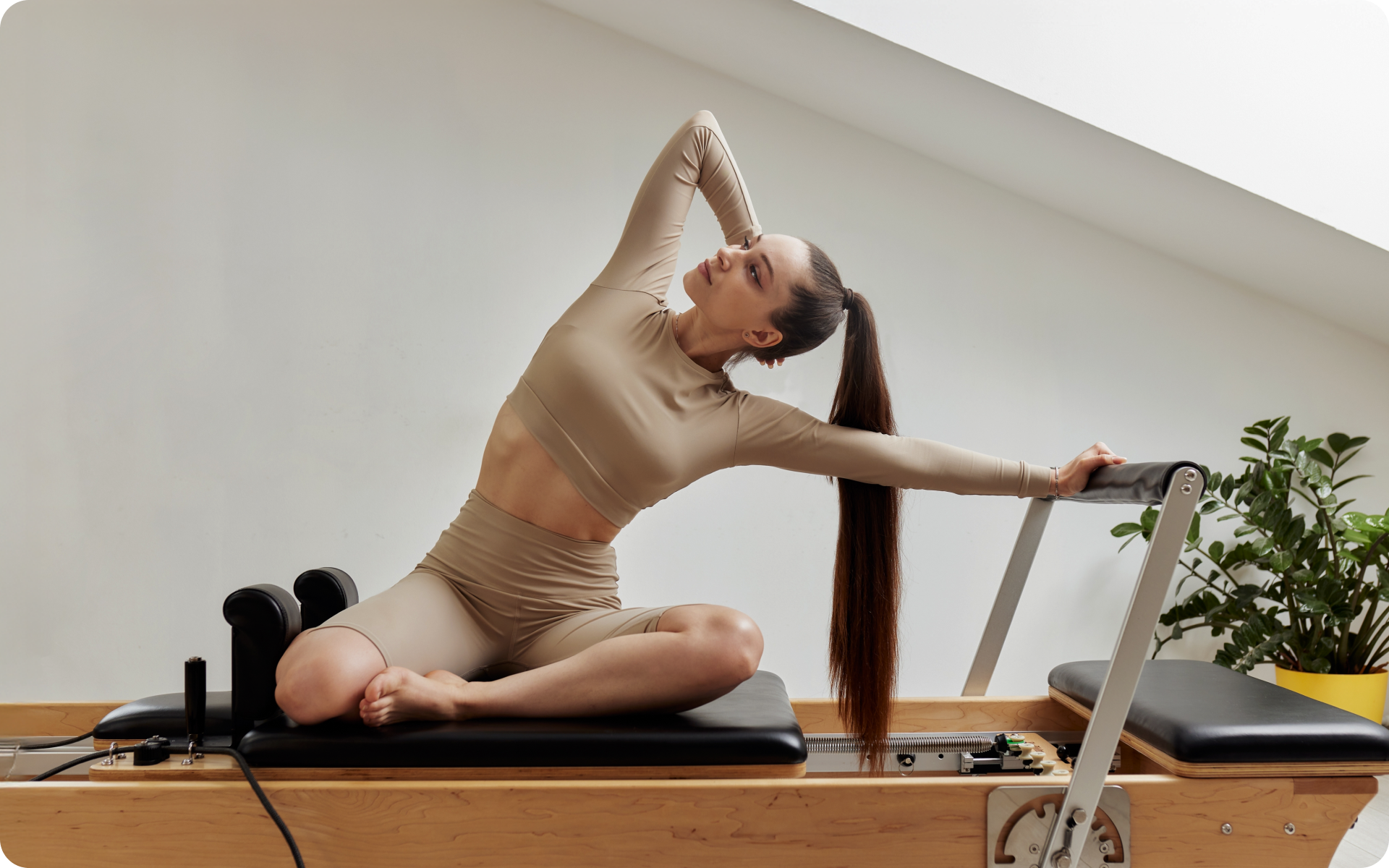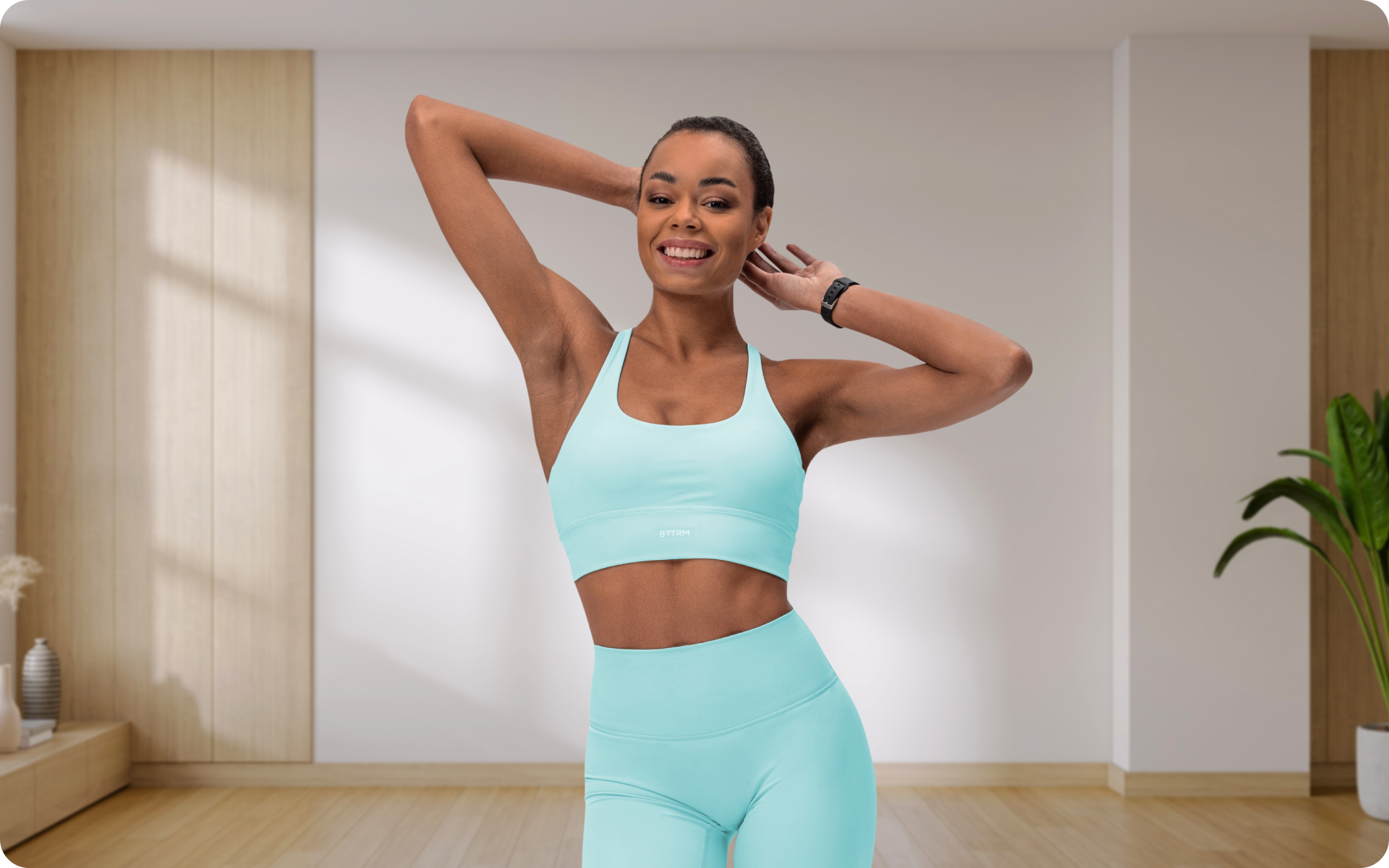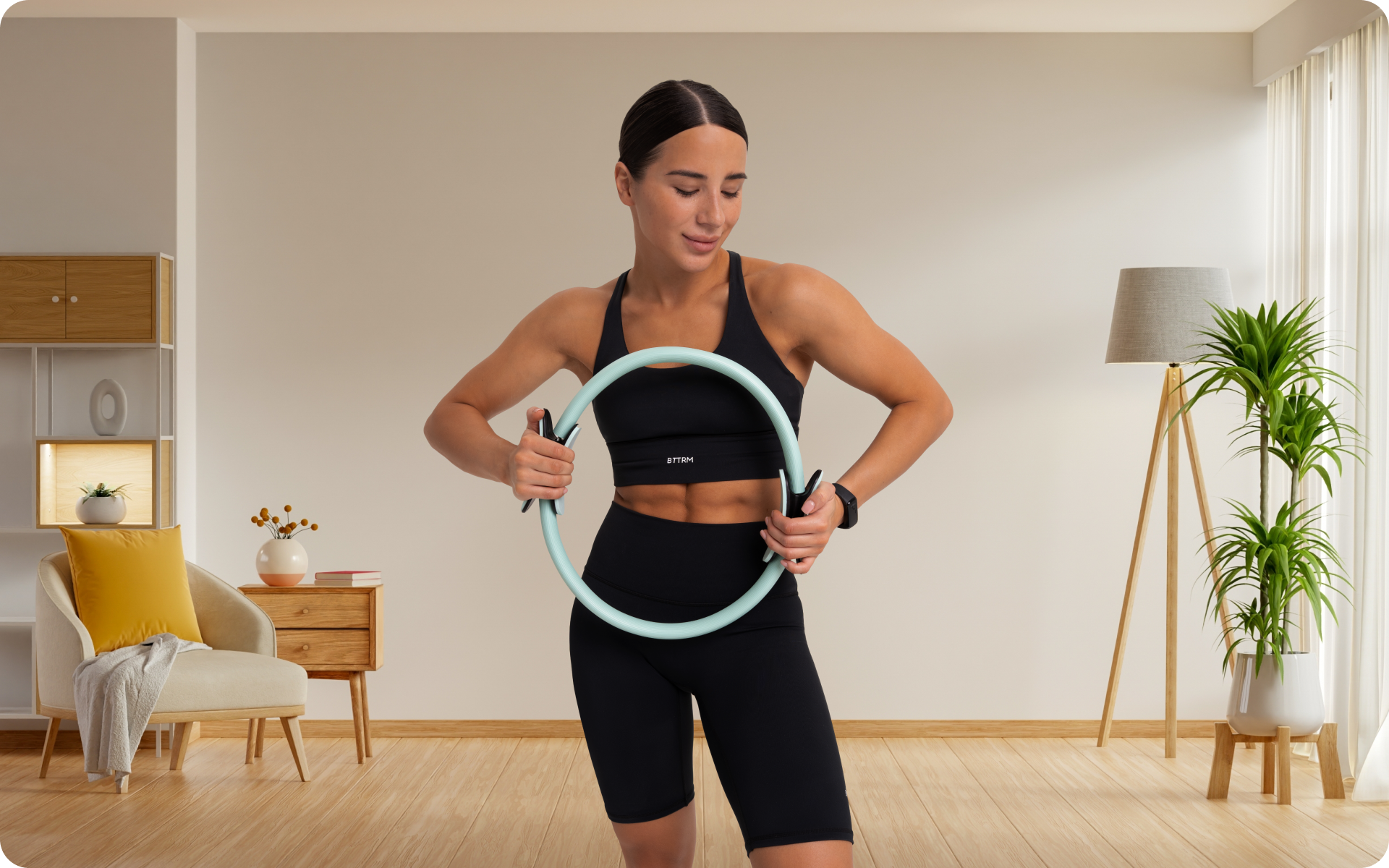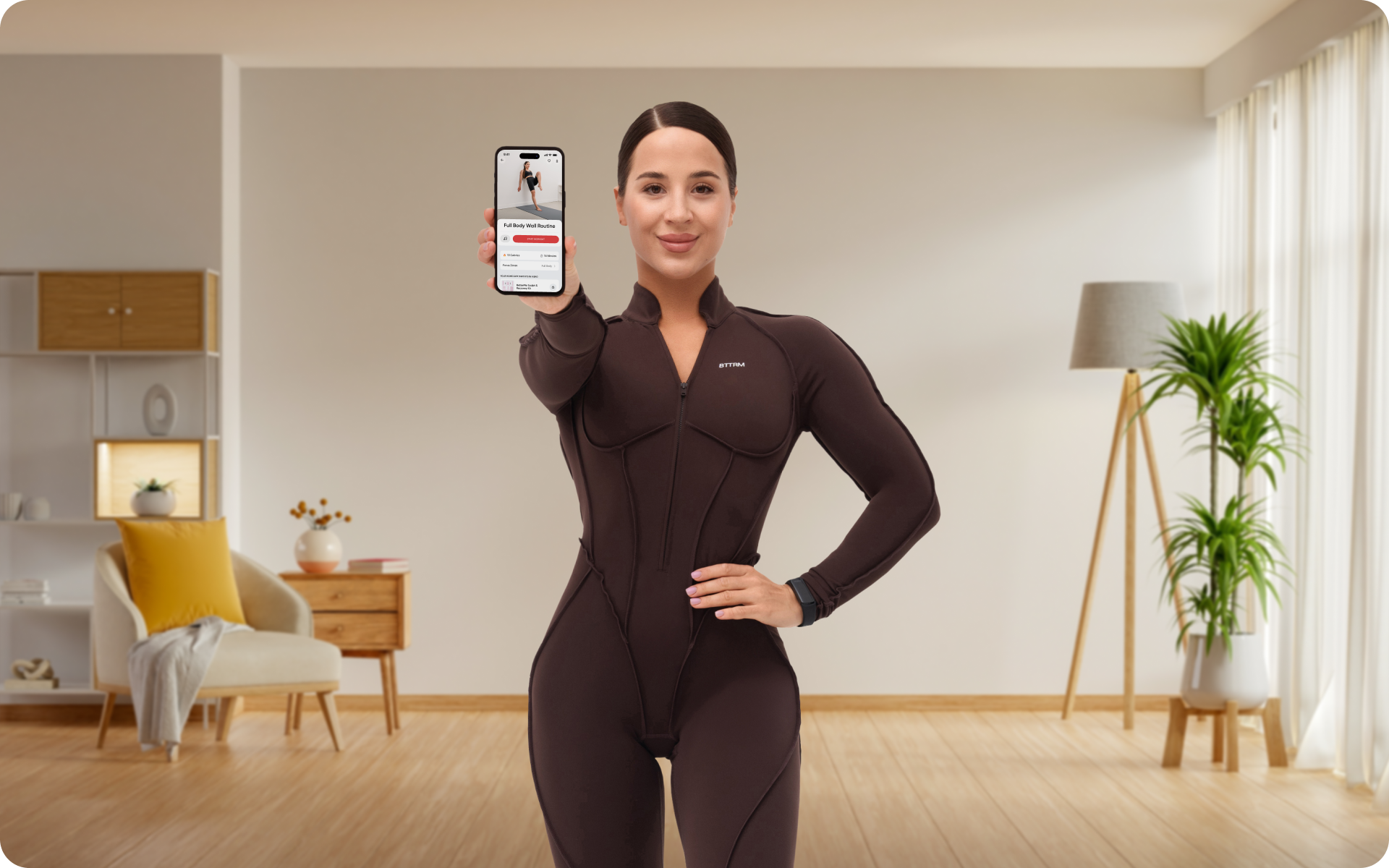Pilates is quickly becoming a favorite among those seeking both mental and physical wellness for many reasons. The main focus of Pilates is alignment, as aligning the body correctly helps us prevent injuries and reduce strain on muscles and joints. Moreover, it Improves posture and alleviates muscle imbalances. Pilates can improve core strength, flexibility, and overall body conditioning in a way that’s both gentle and challenging.
More importantly, Pilates emphasizes controlled movements and breathing, which improves mental focus and reduces stress (2).
Using a ring can elevate your Pilates workout by introducing resistance, making each exercise more challenging and thereby more effective. It takes your workout from basic to dynamic, targeting muscles you didn’t even know you had.
Here’s how to use a Pilates ring to achieve full-body toning and elevate your fitness routine.
What Is a Pilates Ring Workout?
A Pilates ring, also known as a magic circle or fitness circle, is a flexible ring typically made of rubber or metal with padded handles.
It’s designed to be squeezed, stretched, and pulled in various directions, to engage different muscle groups.
Pilates rings come in varying levels of resistance, so you can choose the workout intensity that suits your fitness level.
Our Wall Pilates Core Exercises blog has more workouts you can try.
The Sculpt & Recovery Kit is your personal trainer, ready to unleash a full-body transformation. Grip it, stretch it, balance it; each piece invites you to play your way to a toned physique. With comfort at your fingertips and style at your toes, who knew shaping up could feel so good?
What Is The Purpose of a Pilates Ring?
The Pilates ring primarily engages muscles through isotonic contractions, specifically concentric and eccentric contractions.
- Concentric contractions: During a concentric contraction, the muscle shortens as it generates force against the resistance provided by the Pilates ring. For example, when squeezing the ring together with your hands or legs, the muscles contract to overcome the resistance, resulting in a concentric contraction.
- Eccentric contractions: Eccentric contractions occur when the muscle lengthens while generating force against the resistance. For instance, when slowly releasing the tension in the ring after squeezing it, the muscles lengthen under controlled resistance, leading to an eccentric contraction.
- Additionally, the Pilates ring encourages isometric contractions, where muscles contract to hold a position without changing length, contributing to improved stability and muscle engagement.
The ring helps you engage and strengthen muscles that may be neglected in traditional workouts (3).

What Are The Benefits of Pilates With a Resistance Ring?
The main benefit of using a Pilates ring is that it adds more challenge to your workout, increasing the effectiveness in toning and strengthening muscles.
Other benefits include:
- Increased body awareness – by focusing on controlled movements and alignment, you become more aware of your body and how it moves (1).
- Improved posture – Pilates ring exercises work to strengthen and align those muscles responsible for good posture (1).
- Enhanced flexibility – using a Pilates ring challenges your range of motion, helping increase flexibility in your joints and muscles (1).
- Full-body conditioning – Pilates ring workouts engage multiple muscle groups at once, providing a full-body workout (1).
- Low-impact – the controlled movements of Pilates with a resistance ring make it a low-impact form of exercise that is gentle on joints (1).
Read more: How to Use the BetterMe Pilates Kit for Active Recovery
How Do You Use a Pilates Ring for Beginners?
Before you begin your Pilates ring workout, familiarize yourself with the equipment by holding it in both hands and gently squeezing to feel the resistance.
Does it feel easy? Then you might need a ring with higher resistance.
Next, try pressing the ring between your hands and holding it at chest level to get a feel for how it works.
Make sure to maintain proper form throughout each exercise, engaging your core muscles and keeping your shoulders relaxed. Perform each exercise slowly and with control, squeezing the ring on exhale and releasing it on inhale.
Read about, how to exercise your pelvic muscles, in our pilates for pelvic floor article.
What Exercises Can I Do With a Pilates Ring?
Below are some exercises to include in your Pilates ring workout:
Pilates Ring Standing Inner Thigh Squeeze
This exercise is a fundamental part of any Pilates ring workout for inner thigh strengthening. It targets the adductors, which are crucial for stabilizing your pelvis and supporting the alignment of your knees. Weak adductors and thighs can increase the risk of injuries, especially in the knees and hips, due to poor biomechanics and instability. That is why strengthening these muscles is highly beneficial as it helps facilitate proper engagement of the core and teaches us to use the core muscles efficiently.
Steps:
- Stand upright with your feet hip-width apart, holding the Pilates ring between your thighs, just above your knees. Maintain micro bend of the knees.
- Gently squeeze the ring using your inner thighs, while you exhale, hold for a count of three, then release slowly on inhale. Don’t release it completely, but keep the slight 10% squeeze each time during inhale and release, engaging muscles even more. This option can be used for more advanced users.
- Repeat for 10-15 squeezes, ensuring that you maintain an upright posture throughout, engaging your core and glutes.
Pilates Ring Arm Press
An effective full-body Pilates ring workout often includes upper body exercises like the arm press. This exercise targets the chest, shoulders, and arms—particularly the triceps and biceps. Strengthening these muscles enhances upper body strength and posture.
Steps:
- Hold the Pilates ring in front of you at chest height, with both hands on the sides of the ring. Elbows pointing to the sides, shoulders down – maintain scapular stabilization.
- Press inward on the ring using your hands, engaging the muscles of your chest and arms.
- Hold the squeeze for a count of three, then slowly release.
- Repeat for 10-15 presses, keeping your back straight and core engaged to maximize effectiveness. Maintain tension in circle at 10%, increase the tension when pressing arms together.
Pilates Ring Bridge Squeeze
A quintessential move for a Pilates ring workout for beginners and a staple in Pilates ring workout at home sessions, the Pilates Ring Bridge Squeeze focuses on the glutes, hamstrings, and core.
By strengthening these muscles, individuals can improve their posture, relieve back pain, and enhance overall lower body strength, making it an ideal exercise in a Pilates ring workout for seniors as well.
Steps:
- Lie on your back with your knees bent and feet flat on the floor, hip-width apart. Place the Pilates ring between your knees.
- Press your arms down into the ground, and as you exhale, lift your hips towards the ceiling by squeezing your glutes and pressing your feet into the floor. Simultaneously, squeeze the ring with your knees. Maintain a neutral position of the pelvis. Try to avoid excessive arch in your spine by engaging core muscles. Keep shoulders and neck relaxed. If you are looking for a more advanced variation, keep the slight tension in a circle even during the release phase.
- Hold the position at the top for a few seconds before slowly lowering your hips back to the starting position, releasing the squeeze on the ring gently.
- Perform 10-15 repetitions. This exercise is especially beneficial as part of a full-body Pilates ring workout.
Pilates Ring Single-Leg Bridge Squeeze
The Pilates Ring Single-Leg Bridge Squeeze is another excellent foundational movement in a Pilates ring workout for beginners that can be practiced in a Pilates ring workout at home.
It targets the hamstrings and glutes, focusing on unilateral strength, which can improve balance and rectify strength imbalances in the lower body. It’s also a beneficial inclusion in a Pilates ring workout for seniors, promoting lower body strength and balance.
Steps:
- Begin in the same position as the Pilates Ring Bridge Squeeze, but extend one leg towards the ceiling, keeping the Pilates ring positioned between your thighs.
- Press your arms and the foot of your bent leg into the floor to elevate your hips, while squeezing the Pilates ring between your thighs.
- Hold the bridge position for a few seconds before gently lowering back down to the initial position.
- Perform 8-10 repetitions on each leg, and focus on maintaining your hip bones on the same level (iliac crests) throughout the movement.

Pilates Ring Press
Consider integrating the Pilates Ring Outer Thigh Press into your Pilates ring workout at home for a dynamic exercise that targets the adductors. Strengthening these muscles is crucial for side-to-side movements, stability, and reducing knee stress.
This exercise is an excellent choice for a full-body Pilates ring workout.
Steps:
- Lie on one side with the Pilates ring placed between your ankles, and support your head with your bottom arm while keeping your top hand on the ground in front of you for balance.
- Squeeze the Pilates ring by lifting your top leg and pressing the outer thigh into the ring while keeping your core engaged and hips stacked.
- Hold the squeeze for a few seconds, then slowly release while keeping tension in the ring.
- Perform 10-15 repetitions on each side, ensuring to maintain proper form and alignment throughout the exercise.
Whether you’re looking to simply pep up your fitness routine, jazz up your diet with mouth-watering low-calorie recipes or want to get your act together and significantly drop that number on your scale – BetterMe app has got you covered! Improve your body and revamp your life with us!
Pilates Ring Overhead Arm Press
The Pilates Ring Overhead Arm Press is an excellent exercise for targeting the shoulders, triceps, and upper back muscles. By strengthening these areas individuals can improve their upper body strength, posture, and reduce the risk of shoulder injuries. This exercise also engages the core, promoting better stability and balance.
Steps:
- Sit or stand with your spine straight and core engaged. Hold the Pilates ring with both hands and extend your arms straight in front of you at chest level.
- Slowly raise the ring overhead, fully extending your arms while keeping your shoulders down away from your ears.
- Press inward on the ring slightly as you hold it overhead for a count of three, engaging the muscles of your shoulders, upper back, and triceps.
- Gently lower the ring back to chest level.
- Repeat for 10-15 repetitions, ensuring to maintain good posture and core engagement throughout the exercise. Keep your arms straight, and avoid bending the elbows. Lift your arms as high as the flexibility of your shoulder allows. Maintain a slight tension in a circle on inhale and increase the tension during exhale.
Pilates Ring Supine Leg Press
The Pilates Ring Supine Leg Press primarily works the quadriceps, hamstrings, and glutes. Strengthening these lower body muscles contributes to better support for the knees and hips, enhances athletic performance, and can support the prevention of lower back pain. This exercise also engages the core muscles, further stabilizing the spine.
Steps:
- Lie on your back with your arms by your sides, knees bent, and feet flat on the floor. Place the Pilates ring between your ankles.
- Press your arms into the ground for stability and lift your feet off the floor, bringing your knees above your hips to create a 90-degree angle with your legs.
- Gently press your ankles into the ring while simultaneously extending your legs straight up towards the ceiling.
- Slowly bend your knees and return to the starting position, maintaining controlled movements throughout.
- Perform 10-12 repetitions, focusing on keeping your core engaged. Avoid pressing your spine into the floor, and maintain a neutral position.
Pilates Ring Supine Inner Thigh Press
The Pilates Ring Supine Inner Thigh Press primarily targets the adductor muscles of the inner thigh. Strengthening these muscles aids in stabilizing the pelvis, contributes to a more balanced lower body muscle structure, and can improve agility and performance in activities that require quick lateral movements. Enhancing the strength of the inner thighs also supports knee health by balancing muscular forces around the joint.
Steps:
- Lie on your back with your legs extended upwards toward the ceiling, placing the Pilates ring between your ankles.
- Keep your arms flat on the floor alongside your body for support, with your palms facing down.
- Squeeze the Pilates ring by pressing your inner thighs inward, focusing on engaging the adductor muscles.
- Hold the squeeze for a few seconds, then slowly release, maintaining a slight tension in the ring.
- Perform 10-15 repetitions, ensuring to keep your core engaged and your lower back neutral to avoid arching.

Pilates Ring Supine Outer Thigh Press
The Pilates Ring Supine Outer Thigh Press focuses on the abductor muscles, including the gluteus medius and minimus. These muscles are crucial for lateral leg movements and contribute significantly to hip stability and proper gait.
Strengthening the outer thighs can decrease the risk of knee injuries by ensuring proper leg alignment and balance between the inner and outer thigh muscles.
Steps:
- Lie on your back, legs extended straight up towards the ceiling, with the Pilates ring placed around the outside of your thighs, just above your knees.
- Place your arms flat on the ground beside you, palms facing down, to stabilize your upper body.
- Activate your core and press outward against the ring with your thighs, engaging the muscles of your outer thighs.
- Hold the outward press for a few seconds, ensuring your hips and spine remain in a neutral position on the floor.
- Slowly release the tension, allowing your thighs to come slightly inward, but keep some resistance in the ring.
- Repeat for 10-15 repetitions, focusing on maintaining a steady, controlled movement and keeping your core engaged to support your back.
Pilates Ring Chest Press
The Pilates Ring Chest Press targets the pectoral muscles in the chest, along with the deltoids, and triceps. Strengthening these muscles can enhance upper body strength, improve posture, and contribute to a more effective arm and shoulder movement. This exercise is also beneficial for enhancing core stability as it engages the abdominal muscles when performed correctly.
Steps:
- Lie on your back with your knees bent and feet flat on the floor, holding the Pilates ring with both hands directly above your chest. Elbows bent.
- Press your hands into the sides of the ring, squeezing it inward while keeping your arm movements controlled.
- Hold the press for a few seconds, then slowly release to the starting position, maintaining tension in the ring throughout.
- Perform 10-15 repetitions, ensuring to keep your core engaged and your lower back pressed to the floor.
Pilates Ring Overhead Tricep Press
The Pilates Ring Overhead Tricep Press is designed to target the triceps, the muscles at the back of the upper arm. Strengthening the triceps contributes to better arm definition, supports proper shoulder and elbow joint function, and is essential for pushing movements in daily activities and sports. This exercise also engages the core for added stability.
Steps:
- Sit up tall or stand with your feet hip-width apart, holding the Pilates ring above your head with both hands.
- Keeping your elbows close to your head, slowly bend your elbows to lower the ring behind your head.
- Press upwards by straightening your arms, squeezing the ring slightly as you return to the starting position.
- Make sure your movements are slow and controlled, focusing on isolating the tricep muscles.
- Complete 8-12 repetitions, maintaining good posture and keeping your core engaged throughout the exercise.
Read more: Does Wall Pilates Work? Discover Why Wall Pilates is the New FitTok Hype
Can You Build Muscle with a Pilates Ring?
Yes; Pilates Rings can help build muscle by targeting and isolating specific muscle groups in the body.
By performing exercises with the Pilates Ring, you engage and strengthen muscles that may not typically be targeted in traditional weightlifting or resistance training workouts (1).
Additionally, using the ring adds an element of instability to the movements. Instability engages the smaller stabilizing muscles, which play a crucial role in maintaining balance and control during exercises.
These smaller muscles, often referred to as the intrinsic muscles, include those surrounding the joints and spine, as well as muscles in the feet, hands, and core
Find out how you can correct your posture with Pilates in our Pilates for posture article.
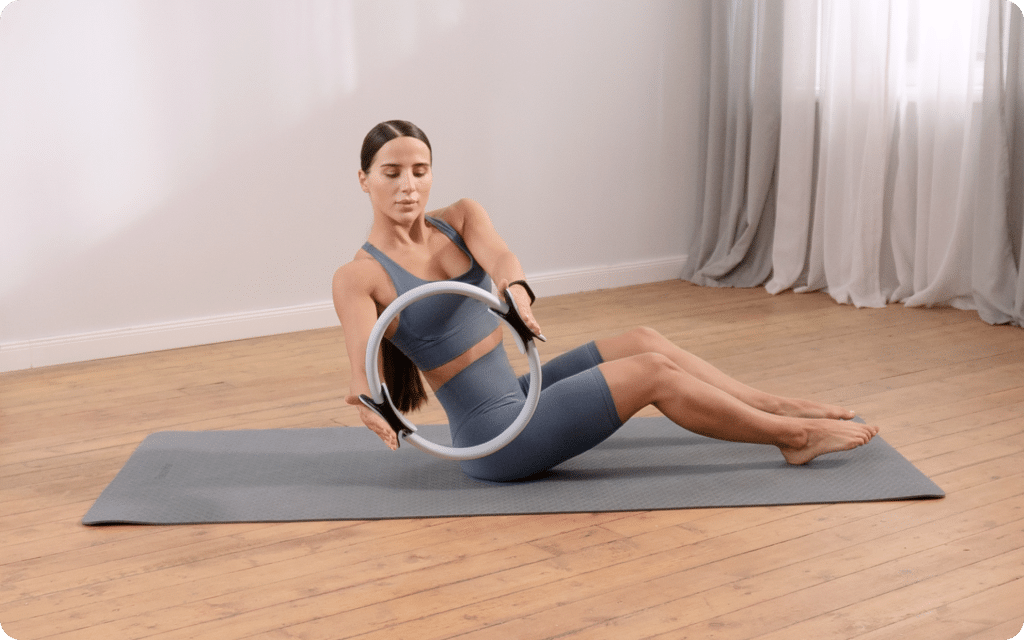
FAQs
Is Pilates Ring Good for Inner Thighs?
Yes, Pilates Rings are an excellent tool for targeting the inner thigh muscles. The resistance provided by the ring allows for a more intense yet controlled movement that effectively strengthens and tones the inner thigh area.
Why Are Pilates Ring Exercises Harder?
Pilates ring exercises can be more challenging due to the added resistance and instability provided by the ring. This requires increased muscle engagement, leading to a more intense workout (3).
Is Pilates Better Than Resistance Training?
Pilates may be preferable to resistance training for some; it focuses on controlled, low-impact movements that aim to improve flexibility, balance, and posture (2).
Anyone looking for a low-impact and more mindful approach to strength training may find Pilates better suited for them(2) .
However, resistance training can also be beneficial for building muscle mass and increasing overall strength.
Can Pilates Replace The Gym?
Pilates can be a suitable alternative to the gym for many individuals. It is a low-impact form of exercise that does not require any equipment, making it convenient and accessible for home workouts. Additionally, Pilates offers various exercises targeting different muscle groups, promoting overall strength and stability (1).
However, the gym may be necessary for those looking to build significant muscle mass or use specific equipment not available in Pilates workouts.
The Bottom Line
A Pilates ring workout is an effective way to strengthen and tone various muscle groups, while promoting core stability and full-body movement control. It can be a valuable addition to any fitness routine, whether as a supplement to other forms of exercise or as a standalone workout.
DISCLAIMER:
This article is intended for general informational purposes only and does not serve to address individual circumstances. It is not a substitute for professional advice or help and should not be relied on for making any kind of decision-making. Any action taken as a direct or indirect result of the information in this article is entirely at your own risk and is your sole responsibility.
BetterMe, its content staff, and its medical advisors accept no responsibility for inaccuracies, errors, misstatements, inconsistencies, or omissions and specifically disclaim any liability, loss or risk, personal, professional or otherwise, which may be incurred as a consequence, directly or indirectly, of the use and/or application of any content.
You should always seek the advice of your physician or other qualified health provider with any questions you may have regarding a medical condition or your specific situation. Never disregard professional medical advice or delay seeking it because of BetterMe content. If you suspect or think you may have a medical emergency, call your doctor.
SOURCES:
- Pilates – health benefits (2022,betterhealth.vic.gov.au)
- Resistance Training Load Effects on Muscle Hypertrophy and Strength Gain: Systematic Review and Network Meta-analysis (2022,nih.gov)
- Pilates: how does it work and who needs it? (2012,nih.gov)

